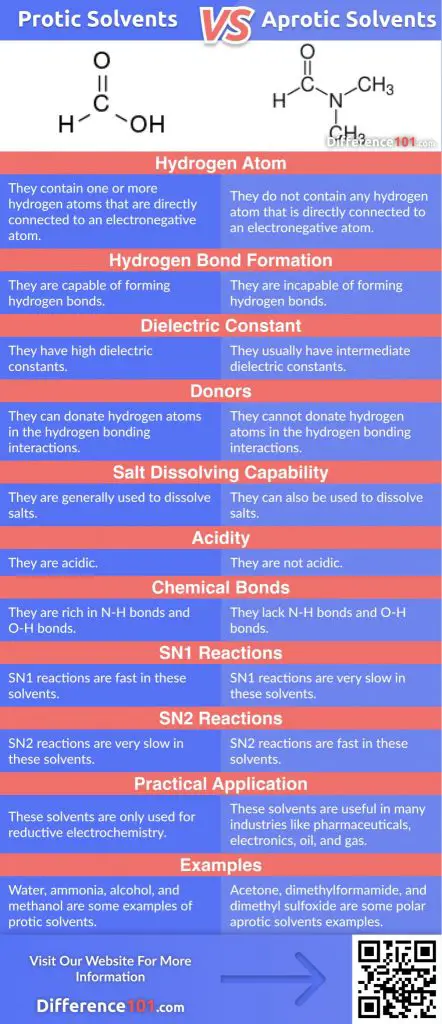The biggest protic vs. aprotic solvent difference lies in their ability to form hydrogen bonds with nitrogen, oxygen, or fluorine. A protic solvent contains a highly polarized bond to hydrogen whereas an aprotic solvent doesn’t. Protic solvents are hydrogen bond donors while aprotic solvents are not.
Let’s take a closer look at Protic vs. Aprotic solvents
| Donors | Protic are hydrogen atom donors as against aprotic |
| Labile | Protic contains an H+ labile but aprotic does not |
| Dielectric constants | Protic have higher dielectric constants than aprotic |
| Preferred reactions | Protic prefers SN1 reactions while aprotic prefers SN2 |
Table of Contents
What Are Protic Solvents?
Protic is the one that is related to protons. Hence, protic means the solvent that releases protons like alcohol or water. These solvents contain at least one hydrogen atom that is directly connected to an electronegative atom and are, therefore, capable of hydrogen bonding. They can donate hydrogen atoms in hydrogen bonding interactions.
What Are Aprotic Solvents?
An aprotic solvent lacks hydrogen atoms to donate in the hydrogen bonding interactions. They can, thus, only accept a hydrogen atom and not donate any. These solvents usually have high dipole moments and intermediate dielectric constants. They do not contain any labile protons.
Protic vs. Aprotic Pros and Cons
Protic Solvents Pros and Cons
Pros of Protic
- They are capable of hydrogen bonding.
- They are generally used to dissolve salts.
- SN1 reactions are extremely fast in polar protic solvents.
Cons of Protic
- They are prone to proton reduction.
- SN2 reactions are slower in these solvents.
- These solvents are only used for reductive electrochemistry.
Aprotic Pros and Cons
Pros of Aprotic
- They can accept hydrogen bonds.
- SN2 reactions are extremely fast in polar aprotic solvents.
- These solvents are useful in many industries like pharmaceuticals, electronics, oil, and gas.
Cons of Aprotic
- These solvents are incapable of hydrogen bonding.
- SN1 reactions are slower in these solvents.
Protic and Aprotic Solvents Similarities Explained
- Both protic and aprotic are polar solvents.
- Both can undergo SN1 and SN2 reactions.
- Both can dissolve salts.
11 Key Differences Between Protic Solvents and Aprotic Solvents That Must Be Considered
There are several key differences between protic and aprotic solvents that are listed here:
| Basis | Protic solvents | Aprotic solvents |
|---|---|---|
| Hydrogen atom | They contain one or more hydrogen atoms that are directly connected to an electronegative atom. | They do not contain any hydrogen atom that is directly connected to an electronegative atom. |
| Hydrogen bond formation | They are capable of forming hydrogen bonds. | They are incapable of forming hydrogen bonds. |
| Dielectric constant | They have high dielectric constants. | They usually have intermediate dielectric constants. |
| Donors | They can donate hydrogen atoms in the hydrogen bonding interactions. | They cannot donate hydrogen atoms in the hydrogen bonding interactions. |
| Salt dissolving capability | They are generally used to dissolve salts. | They can also be used to dissolve salts. |
| Acidity | They are acidic. | They are not acidic. |
| Chemical bonds | They are rich in N-H bonds and O-H bonds. | They lack N-H bonds and O-H bonds. |
| SN1 reactions | SN1 reactions are fast in these solvents. | SN1 reactions are very slow in these solvents. |
| SN2 reactions | SN2 reactions are very slow in these solvents. | SN2 reactions are fast in these solvents. |
| Practical application | These solvents are only used for reductive electrochemistry. | These solvents are useful in many industries like pharmaceuticals, electronics, oil, and gas. |
| Examples | Water, ammonia, alcohol, and methanol are some examples of protic solvents. | Acetone, dimethylformamide, and dimethyl sulfoxide are some polar aprotic solvents examples. |
Comparison Chart

Comparison Video
The Final Words
Protic and aprotic both are polar solvents. Protic solvents contain one or more atoms of hydrogen connected directly to an electronegative atom. This allows them to form a hydrogen bond i.e. N-H bond and O-H bond. These can also be called protonic solvents because of their ability to release protons and undergo proton reduction.
Aprotic solvent, on the other hand, contains no hydrogen atom that can be connected directly to an electronegative atom. Because of this reason, they are incapable of forming any hydrogen bond.
Protic and Aprotic FAQ
What is the Difference Between Protic and Aprotic Solvent?
Protic solvents contain one or more hydrogen atoms that help them form a hydrogen bond. Aprotic solvents do not contain any hydrogen atom connected to an electronegative atom thereby cannot form a hydrogen bond.
What are Protic and Aprotic Solvents? Give an Example.
Protic and aprotic solvents are distinguished with their ability to form hydrogen bonds with nitrogen, oxygen, or fluorine. Whereas the former tends to form such bonds, the latter lacks the ability. An example of protic solvent is water and of aprotic solvent is acetone.
What Does Protic Mean?
Protic is the one that is related to protons. Hence, protic means the solvent that releases proton.
What Do You Mean By Aprotic Solvent?
An aprotic solvent lacks hydrogen atoms to donate in the hydrogen bonding interactions. These solvents can, thus, only accept hydrogen atoms during such interactions.
Is DMF Aprotic or Protic?
DMF is aprotic as it lacks any direct hydrogen bond with electronegative atoms like oxygen and nitrogen.
How Do You Know if it’s Protic or Aprotic?
The easiest way to know protic or aprotic solvent is to check whether any hydrogen atom is directly connected to any electronegative atom. The presence of such a bond means protic solvent and its absence results in an aprotic one.
What is the Strongest Solvent?
With a dielectric constant of 78.5, water is considered the strongest solvent of all. (Ref. 1)
Is Acetone Protic or Aprotic?
Acetone is aprotic due to the absence of a direct hydrogen bond with oxygen.
Why is Acetone considered a Polar Aprotic Solvent?
The polarity of any solvent is indicated by its dielectric constant greater than 5 and also a dipole moment of more than 1.6D. In the case of acetone, these values are 21 and 2.88D respectively. Hence, it is polar. And due to the absence of a direct hydrogen bond with oxygen, it is aprotic, too. Hence, it is considered a polar aprotic solvent.
Is Dimethyl Sulfoxide Protic or Aprotic?
The answer to, “Is DMSO protic or aprotic?” lies in the proton presence or absence from the compound. DMSO is very weakly acidic with no protons present. It is, therefore, considered a polar aprotic solvent. It dissolves polar as well as non-polar compounds. (Ref. 2)







